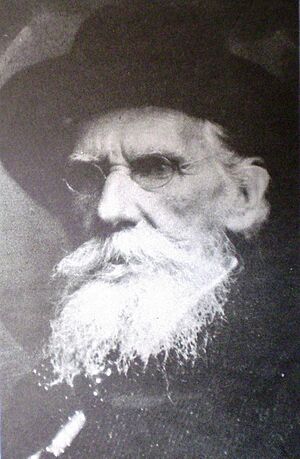Eduardo Sívori facts for kids
Eduardo Sívori (born October 13, 1847 – died June 5, 1918) was an important artist from Argentina. Many people consider him Argentina's very first painter to use the Realism style. Realism in art means painting things exactly as they look in real life.
Contents
Life and Artworks
Early Life and Artistic Start
Eduardo Sívori was born in Buenos Aires, Argentina. His parents were immigrants from Genoa, a city in Italy. Even when he was a child, Eduardo loved art. However, for family reasons, he couldn't follow his dream of becoming an artist right away.
In 1874, Sívori's father asked him to join a business trip to Paris, France. Paris was a famous city for art. Sívori used this chance to visit many art ateliers (which are like art studios or workshops). This experience made him even more excited about art.
Forming an Art Group
When Sívori returned to Buenos Aires, he met other local painters. These included his brother, Alejandro Sívori, José Aguyari, and Eduardo Schiaffino. Schiaffino later became a very famous Symbolist painter in Argentina.
Together, these artists decided to create something special. In 1875, they started the Society for the Promotion of Fine Arts. This was a big step for artists in Argentina. It helped create early "guilds," which are like special groups or clubs for people who do the same kind of work.
Famous Paintings and Awards
Sívori quickly became well-known for his painting called Dolce far niente. This Italian phrase means "Sweet Do Nothing." He won a gold medal for this artwork in 1880 at the Continental Art Salon in Buenos Aires.
In 1882, he went back to Paris. There, he got to study with a famous artist named Jean Paul Laurens. After this, Sívori created another very important painting called El despertar de la criada. This means "Waking of the Servant" and is perhaps his most famous work.
Sívori's fame grew, and he traveled to the United States. In 1884, he won another gold medal at the St. Louis Exposition. He won it again for his painting Dolce far niente!
Later Career and Legacy
After his travels, Sívori started to focus on commercial art. This means he painted for clients who paid him. He created many portraits (paintings of people) and landscapes (paintings of nature). One well-known painting from this time was a portrait for a local stockbreeder named Godofredo Daireaux in 1903.
His beautiful paintings of nature, especially the flat grasslands of Argentina called the "pampas," earned him a special nickname. People called him the "portraiteur of the pampas."
His connections and hard work helped his art group become official. In 1905, his guild became part of the National Academy of Fine Arts. Sívori was even named the president of this important academy in 1910.
Eduardo Sívori passed away in Buenos Aires in 1918. He was 70 years old. To honor him, a new art museum was named after him in 1938. It is called the Eduardo Sívori Museum.
See also
 In Spanish: Eduardo Sívori para niños
In Spanish: Eduardo Sívori para niños


